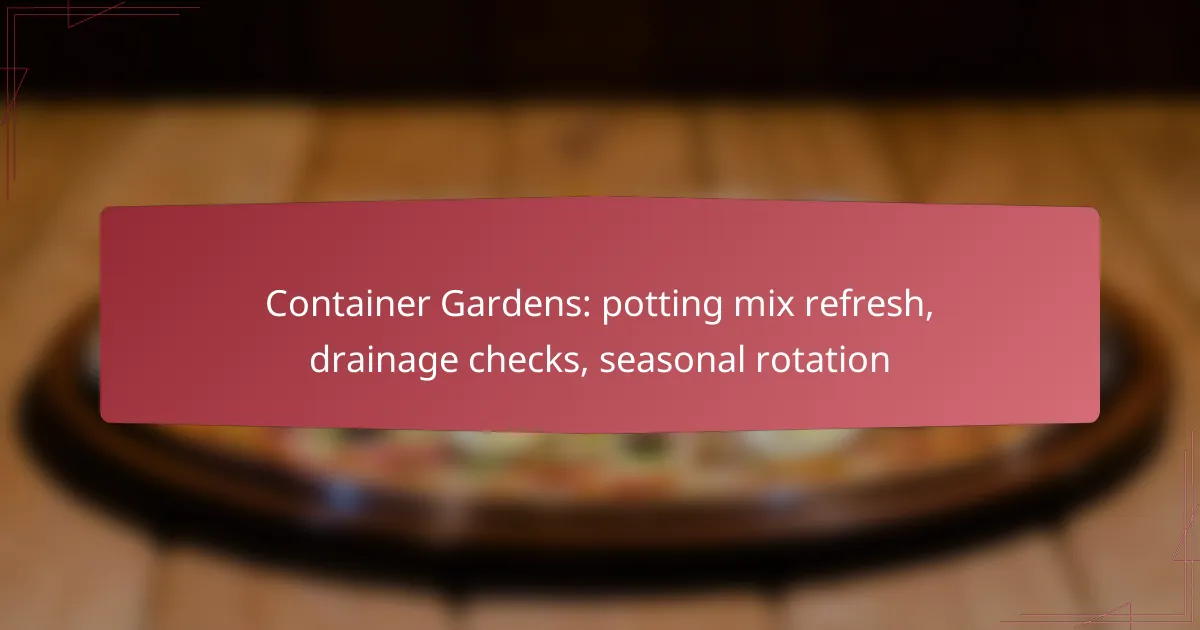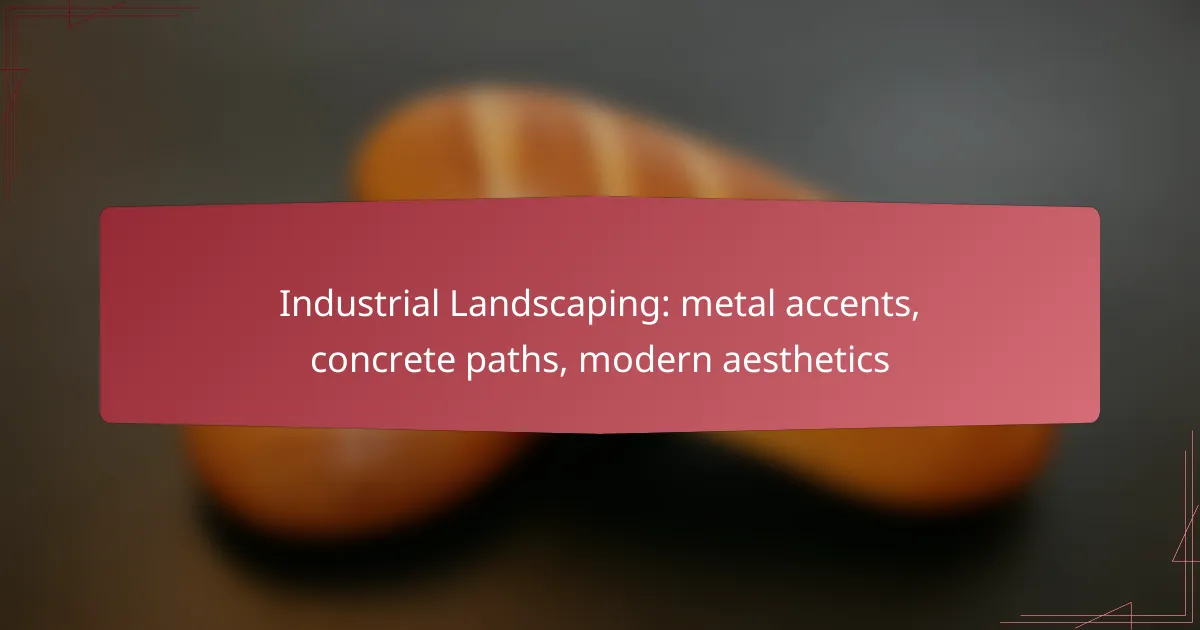Container gardens thrive with proper care, making it essential to refresh potting mix, check drainage, and rotate plants seasonally. By replacing old soil and adding nutrients, you support healthy growth while regular drainage checks prevent waterlogging and root rot. Additionally, seasonal rotation of plants not only enhances aesthetics but also promotes soil health, ensuring your garden remains vibrant year-round.
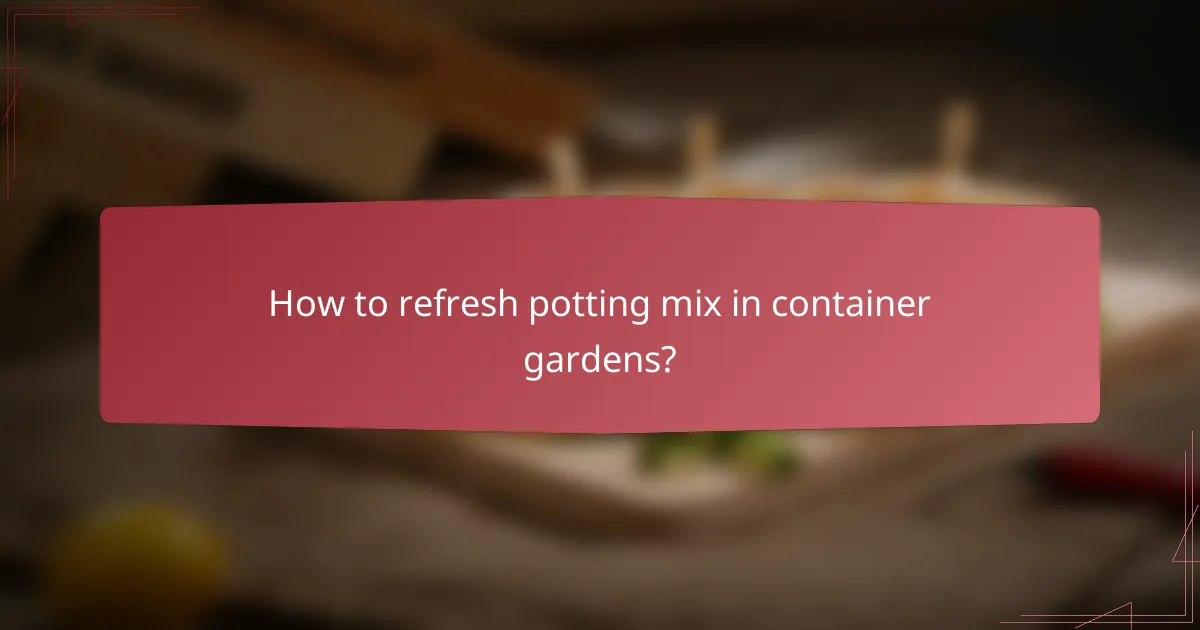
How to refresh potting mix in container gardens?
Refreshing potting mix in container gardens is essential for maintaining healthy plants. This process involves replacing old soil, adding nutrients, and ensuring proper drainage to support plant growth.
Replace old potting mix
Start by removing the old potting mix from your containers. Carefully take out the plants, shaking off excess soil from the roots. Discard the old mix if it appears compacted, discolored, or has an unpleasant odor.
When replacing the potting mix, choose a high-quality blend suitable for your specific plants. For example, use a cactus mix for succulents or a moisture-retaining mix for tropical plants.
Add organic matter
Incorporating organic matter, such as compost or well-rotted manure, enriches the potting mix with essential nutrients. Aim for a mixture that contains about 20-30% organic matter for optimal plant health.
Organic matter improves soil structure, enhances moisture retention, and promotes beneficial microbial activity. This is particularly important for container gardens, where nutrients can leach away more quickly than in ground soil.
Incorporate slow-release fertilizers
Adding slow-release fertilizers to the refreshed potting mix provides a steady supply of nutrients over time. Look for fertilizers with balanced N-P-K ratios, such as 10-10-10, to support overall plant health.
Apply the fertilizer according to package instructions, typically mixing it into the top few inches of soil. This ensures that nutrients are readily available as plants grow, reducing the need for frequent feeding.
Mix in perlite for aeration
To enhance drainage and aeration, mix perlite into the potting mix. A ratio of about 10-20% perlite can significantly improve soil structure, preventing compaction and promoting healthy root development.
Perlite helps retain moisture while allowing excess water to drain away, which is crucial for preventing root rot in container gardens. Check your mix regularly to ensure it maintains good aeration and drainage properties.
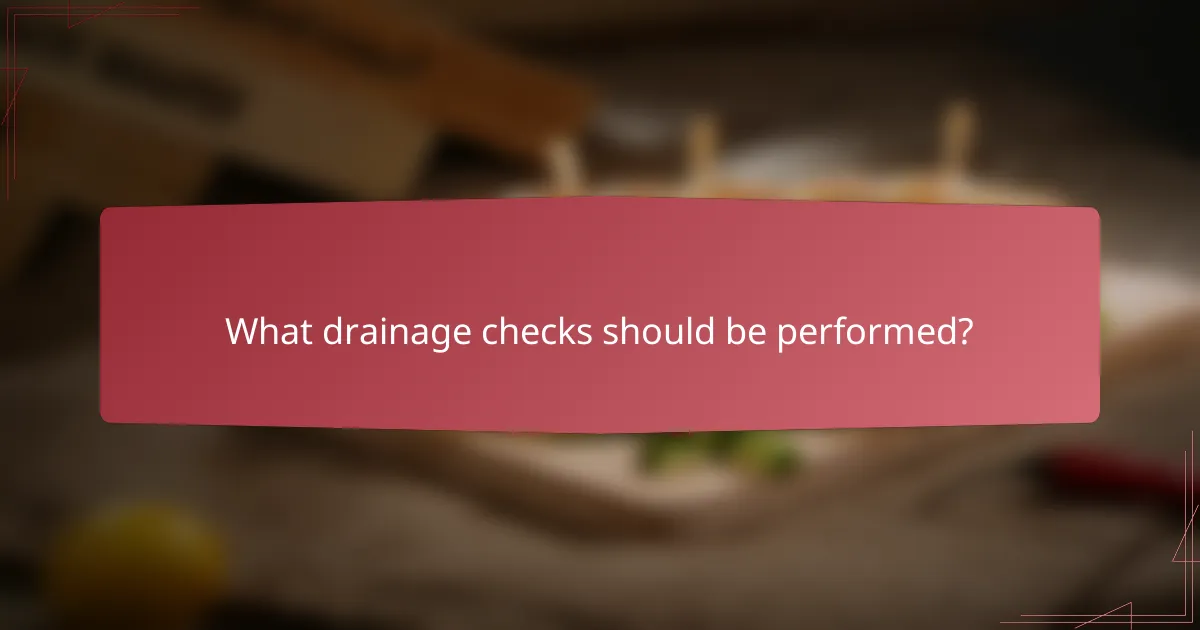
What drainage checks should be performed?
To ensure healthy container gardens, regular drainage checks are essential. These checks help prevent waterlogging, which can lead to root rot and other plant health issues.
Inspect drainage holes for blockages
Start by examining the drainage holes at the bottom of your pots. These openings should be clear to allow excess water to escape, preventing water buildup in the soil.
If you notice any blockages, such as soil or roots, carefully remove them using a small tool or your fingers. Regularly cleaning these holes can significantly improve drainage efficiency.
Test soil moisture levels
Testing soil moisture levels is crucial for determining whether your plants are receiving adequate water. You can use a moisture meter or simply stick your finger into the soil about an inch deep; if it feels dry, it’s time to water.
For container gardens, aim for soil that is consistently moist but not soggy. Adjust your watering schedule based on seasonal changes, as plants may require more water during warmer months.
Evaluate pot material for drainage efficiency
The material of your pots can significantly affect drainage. Terracotta pots, for example, are porous and allow moisture to evaporate, while plastic pots may retain more water.
Consider switching to pots made from materials that promote better drainage if you notice persistent issues. Choosing pots with built-in drainage features can also enhance water management in your container garden.
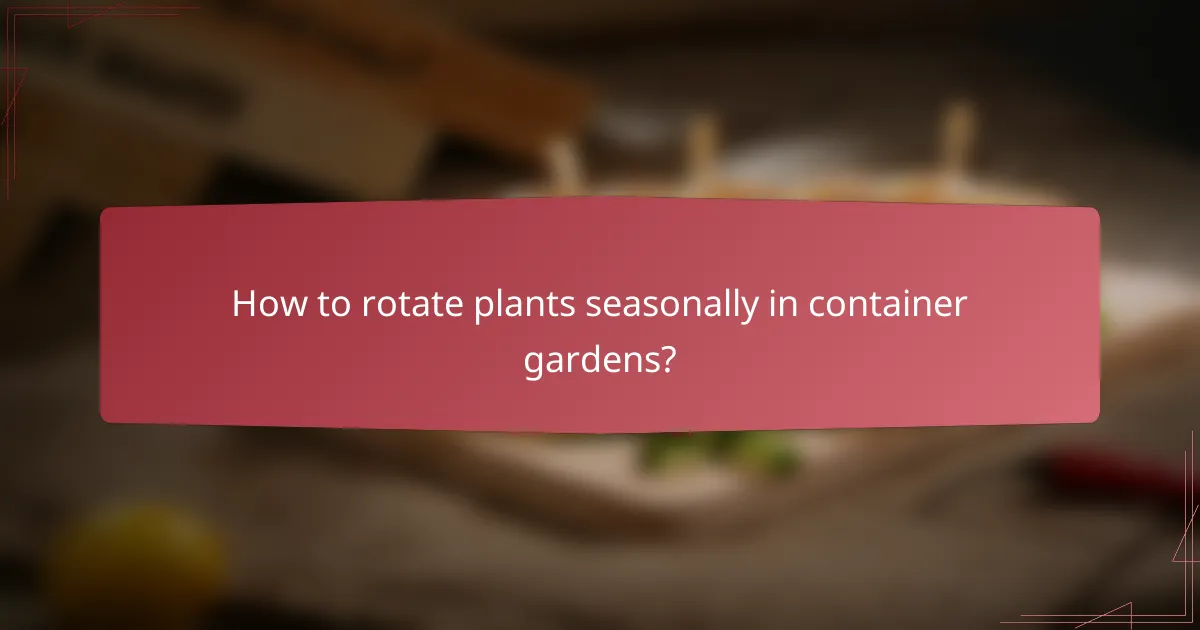
How to rotate plants seasonally in container gardens?
Seasonal plant rotation in container gardens involves changing the types of plants you grow based on the time of year to optimize growth and aesthetics. This practice enhances soil health and ensures that your garden remains vibrant throughout the seasons.
Identify seasonal plant varieties
Choosing the right seasonal plant varieties is crucial for successful rotation. For spring and summer, consider annuals like petunias or marigolds, while fall and winter can feature hardy perennials such as pansies or ornamental cabbage.
Research local gardening resources or extension services to find specific varieties that thrive in your area. This can help you select plants that not only look good but also adapt well to your container conditions.
Plan for sun exposure changes
As seasons change, so does the angle and intensity of sunlight. In spring and summer, many plants require full sun, while some may thrive in partial shade during the cooler months. Assess your containers’ locations to ensure they receive adequate light throughout the year.
Consider moving containers to different spots or using reflective surfaces to maximize sunlight exposure. Regularly monitor your plants for signs of stress, such as wilting or yellowing leaves, which can indicate insufficient light.
Consider local climate conditions
Your local climate significantly impacts plant selection and rotation. In warmer regions, you might be able to grow tropical plants year-round, while cooler areas may require more careful selection of frost-resistant varieties in winter.
Stay informed about seasonal weather patterns, such as average temperatures and rainfall, to make informed decisions about which plants to rotate. This knowledge will help you avoid common pitfalls, such as planting tender species too early in the spring or neglecting to protect them from frost in the fall.
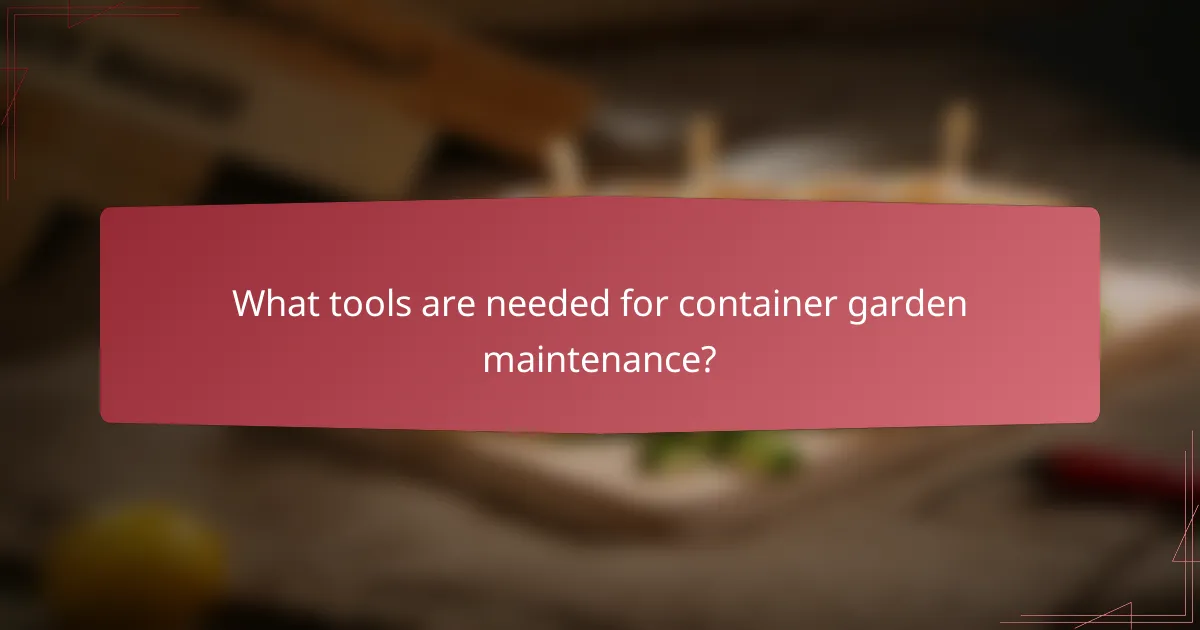
What tools are needed for container garden maintenance?
Essential tools for container garden maintenance include a garden trowel, a soil moisture meter, and pruning shears. These tools help ensure that your plants remain healthy and well-cared-for throughout the growing season.
Garden trowel for mixing
A garden trowel is crucial for mixing potting soil and amending it with fertilizers or compost. This small hand tool allows for precise control when working in confined spaces like containers.
When using a trowel, aim for a sturdy model with a comfortable grip. Look for one with a pointed blade for easier digging and mixing, especially in dense potting mixes.
Soil moisture meter for checking
A soil moisture meter is an invaluable tool for determining when to water your container plants. This device provides a clear reading of moisture levels, helping you avoid overwatering or underwatering.
Choose a moisture meter that is easy to read and suitable for container use. Regularly check the moisture levels, aiming for a balance where the soil is moist but not soggy, typically around 20-30% moisture for most plants.
Pruning shears for plant care
Pruning shears are essential for maintaining the health and shape of your container plants. They allow you to trim dead or overgrown branches, promoting better air circulation and encouraging new growth.
When selecting pruning shears, look for a sharp, lightweight pair that fits comfortably in your hand. Regularly clean and sharpen the blades to ensure clean cuts, which helps prevent disease in your plants.

How to choose the right potting mix for different plants?
Choosing the right potting mix is essential for the health of your plants. Different plants have varying needs for nutrients, drainage, and moisture retention, which can be met by selecting an appropriate mix.
Match mix to plant type
Different types of plants require specific potting mixes to thrive. For example, succulents and cacti need a well-draining mix with sand or perlite, while tropical plants prefer a richer, moisture-retaining blend. Always check the plant’s requirements before selecting a mix.
Herbs and vegetables often benefit from a balanced potting mix that includes organic matter for nutrients. Consider using a mix designed specifically for edible plants to ensure they receive the right nutrients for growth.
Consider pH levels
The pH level of potting mix affects nutrient availability for plants. Most plants prefer a slightly acidic to neutral pH, typically between 6.0 and 7.0. Testing the pH of your potting mix can help you determine if it meets your plants’ needs.
For acid-loving plants like blueberries or azaleas, a mix with a lower pH is beneficial. You can amend standard potting soil with materials like peat moss or sulfur to lower the pH if necessary.
Evaluate moisture retention properties
Moisture retention is crucial for plant health, especially in container gardens where soil can dry out quickly. A good potting mix should balance moisture retention and drainage. Look for mixes that contain ingredients like coconut coir or vermiculite for better water retention.
When selecting a mix, consider the plant’s water needs. For drought-tolerant plants, choose a mix that drains well, while moisture-loving plants may need a mix that retains more water. Regularly check the moisture level in your containers to ensure optimal growth.
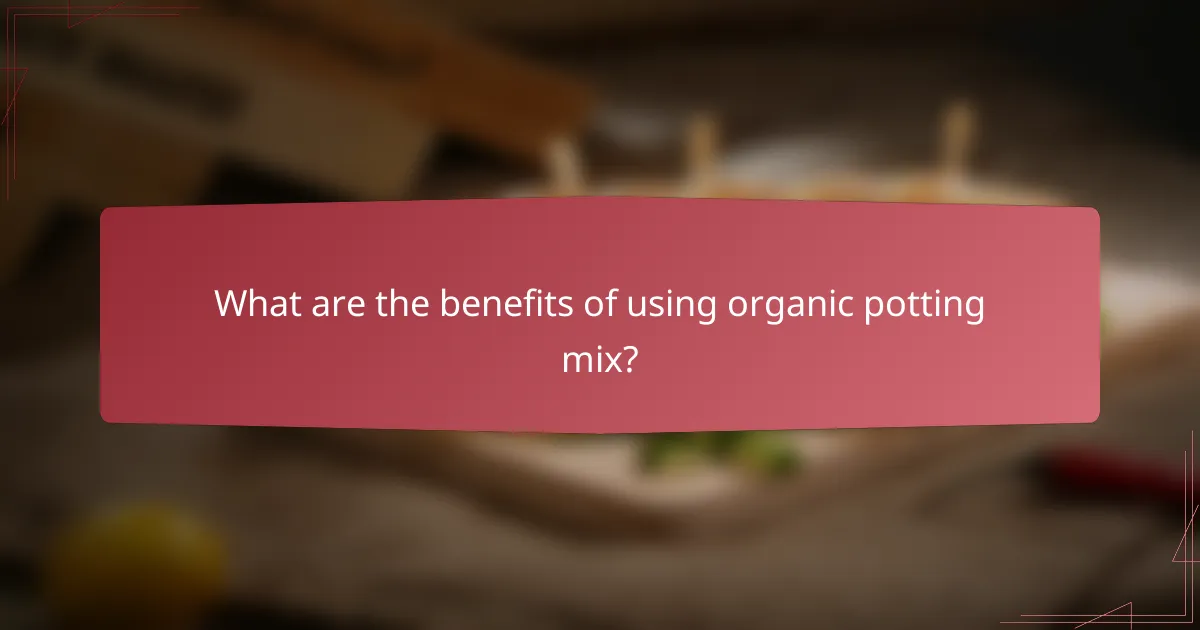
What are the benefits of using organic potting mix?
Organic potting mix offers numerous advantages for container gardening, including improved soil structure and increased microbial activity. These benefits lead to healthier plants and more productive growth, making it a preferred choice for gardeners seeking sustainable options.
Improved soil health
Using organic potting mix enhances soil health by promoting a diverse ecosystem of beneficial microorganisms. These microbes break down organic matter, improving soil structure and aeration, which facilitates root growth and water retention.
Additionally, organic mixes often contain components like compost and peat, which contribute to a balanced environment for plants. This balance helps prevent soil compaction and encourages the development of strong root systems.
Enhanced nutrient availability
Organic potting mix increases nutrient availability through the slow release of essential elements as organic matter decomposes. This gradual process ensures that plants receive a steady supply of nutrients over time, reducing the need for frequent fertilization.
Common ingredients such as worm castings and bone meal provide a rich source of nitrogen, phosphorus, and potassium. By using organic potting mix, gardeners can create a nutrient-dense environment that supports robust plant growth and minimizes the risk of nutrient leaching.
